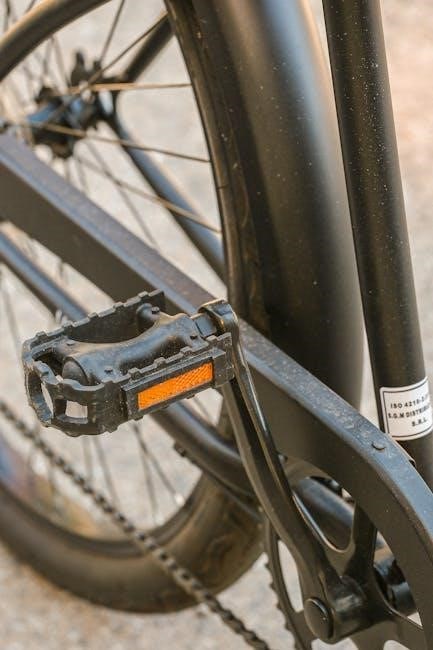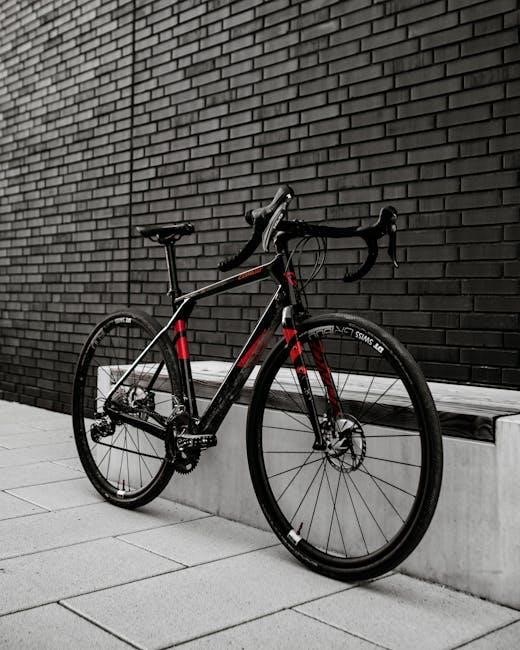Choosing the right frame size is crucial for comfort, performance, and efficiency. Specialized offers detailed size charts based on height, inseam, and body proportions to ensure optimal fit. This guide provides general and model-specific sizing, helping riders select the perfect bike for their needs.

Key Considerations for Choosing the Right Frame Size
Frame size impacts comfort, performance, and efficiency. Consider rider height, inseam, standover height, and body proportions to ensure proper fit and optimal riding experience.
Understanding Frame Size and Rider Height
Frame size and rider height are closely linked to ensure proper fit and comfort. Specialized road bikes offer size charts that correlate rider height with frame size, ensuring optimal performance. For example, a rider measuring 155-163 cm typically fits a 49-52 cm frame. Standover height is also crucial, as it ensures safety and comfort when dismounting. Proper alignment of the rider’s height with the frame size minimizes discomfort and maximizes efficiency. Specialized models, such as the Tarmac SL7 or Allez, provide specific size ranges to cater to various rider heights, ensuring a tailored fit. This alignment is key to achieving the perfect balance between comfort and performance on the road.

Importance of Proper Fit for Comfort and Performance
A proper fit is essential for maximizing comfort and performance on a Specialized road bike. A well-fitted frame ensures optimal riding posture, reducing discomfort and fatigue during long rides. Correct fit also enhances efficiency, as it allows for better power transfer and control. Standover height, reach, and stack are critical measurements that influence how the bike feels. A bike that is too small or too large can lead to muscle strain and poor handling. Specialized frames are designed to provide a balanced geometry, catering to both comfort and aerodynamics. By aligning the bike’s size with the rider’s body proportions, cyclists can achieve a harmonious riding experience, making the bike feel like an extension of their body.
How to Measure Your Inseam and Body Proportions
To determine the right frame size, start by measuring your inseam, which is the distance from the floor to the top of your inner thigh. Stand barefoot with your feet 6-8 inches apart and place a hardcover book between your legs, flush against your crotch. Measure the height of the book vertically from the floor. This measurement helps estimate your standover height. Next, consider your overall height and body proportions, such as torso length and arm span, as these can influence your riding position. For accuracy, use a flexible tape measure or ask someone to assist. Proper measurements ensure a comfortable and efficient fit, allowing you to maintain optimal posture and control while riding. This step is crucial for selecting the right frame size and maximizing your cycling experience.
Factors Affecting Frame Size Selection
Several factors influence the selection of the ideal frame size for a Specialized road bike. Rider height is the primary consideration, but inseam, standover height, and body proportions also play a significant role. Flexibility and riding style, such as aggressive or relaxed positioning, can affect fit. Additionally, handlebar and seatpost adjustments, as well as weight distribution, impact comfort and performance. Variations in torso length and arm span may require adjustments to stem length or handlebar size. Proper fit ensures optimal power transfer, control, and comfort, making it essential to consider these elements when choosing a frame size. Specialized provides detailed charts to guide riders based on these factors, ensuring the best possible match for their needs and preferences. Accurate measurements and understanding personal riding dynamics are key to making the right choice.
Specialized Road Bike Size Charts
Specialized provides detailed size charts to help riders find their ideal frame size, ensuring comfort, efficiency, and performance. These charts cater to various rider heights and inseam measurements.
General Size Chart for Specialized Road Bikes
Specialized road bikes feature a universal sizing system based on rider height and inseam measurements. The general size chart provides a starting point for selecting the right frame size. For example, riders with a height of 155-163 cm typically fit a 49-51 cm frame, while taller riders (175-183 cm) require a 56-58 cm frame. The chart includes sizes from 44 cm (for shorter riders) up to 65 cm (for taller cyclists), ensuring a wide range of fit options. This guide helps riders match their body dimensions to the appropriate frame size, promoting comfort and performance. However, personal fit preferences may vary, so standover height and body proportions should also be considered for optimal comfort and efficiency.
Size Chart for Specific Models (Tarmac, Allez, Shiv)

Specialized offers tailored size charts for its popular road bike models, ensuring precise fit and performance. The Tarmac SL7, known for its aerodynamics, features frame sizes from 44 cm (for riders 142-155 cm tall) to 65 cm (for riders 188-196 cm tall). The Allez, a more versatile option, ranges from 49 cm (155-163 cm tall) to 62 cm (180-188 cm tall). The Shiv, designed for triathlon and time trials, offers sizes from 50 cm (152 cm tall) to 57 cm (170 cm tall). Each model’s size chart aligns with rider height and inseam, providing a customized fit. Riders should consult the specific model’s chart to match their body dimensions for optimal comfort and efficiency, as sizing may vary slightly between models.
Comparative Size Guide Across Different Models
Specialized’s road bikes, such as the Tarmac, Allez, and Shiv, have distinct size guides tailored to their specific designs. The Tarmac SL7 ranges from 44 cm to 65 cm, catering to riders from 142 cm to 196 cm in height. The Allez offers sizes from 49 cm to 62 cm, suited for riders between 155 cm and 188 cm. The Shiv, designed for triathletes, features sizes from 50 cm to 57 cm, accommodating riders from 152 cm to 170 cm. While there’s overlap in sizes across models, each bike’s geometry differs slightly, so riders should compare their height and inseam with each model’s chart to ensure the best fit. This comparative approach helps riders choose the model that aligns with their riding style and body proportions for maximum comfort and performance.
Official Specialized Road Bike Frame Size Table
The official Specialized road bike frame size table provides precise measurements to match riders with their ideal bike. For the Tarmac SL7, sizes range from 44 cm to 65 cm, corresponding to rider heights of 142 cm to 196 cm. The Allez models are available in sizes 49 cm to 62 cm, suitable for riders between 155 cm and 188 cm. The Shiv, designed for triathlon and time-trial performance, offers sizes from 50 cm to 57 cm, fitting riders from 152 cm to 170 cm. Each model’s size chart is tailored to its specific geometry, ensuring optimal fit and performance. By referencing this table, riders can confidently select a frame size that aligns with their height and riding style, enhancing comfort and efficiency on the road. Specialized’s detailed sizing guide is a valuable resource for anyone seeking the perfect bike fit.

How to Measure Yourself for the Perfect Fit
Accurate measurements are essential for a perfect fit. Measure your height, inseam, and standover height using a wall and hardcover book for inseam. Ensure 1-2 inches of clearance for standover height, optimizing comfort and safety.
Step-by-Step Guide to Measuring Your Height and Inseam
To ensure accuracy, start by measuring your height. Stand barefoot with your back against a wall, feet together, and measure from the floor to the top of your head. Next, measure your inseam, which is the distance from the floor to your crotch. Place a hardcover book between your legs, snug against your groin, and press it firmly into your body. Stand with your back against a wall and measure the distance from the floor to the top of the book. This provides your inseam length. Both measurements are critical for determining the correct frame size, ensuring a proper fit and optimal riding comfort and performance.
Understanding Standover Height and Its Importance
Standover height, the distance from the ground to the top of the bike frame, is crucial for comfort and safety. It ensures there is enough clearance between the rider and the frame, especially when dismounting. A general rule of thumb is to have at least 1-2 inches (2.5-5 cm) of clearance. This allows for a safe and comfortable riding position, preventing discomfort and potential injuries; Proper standover height also contributes to better bike control and maneuverability, making it an essential factor in choosing the right frame size. By considering standover height alongside other measurements, riders can achieve a balanced fit for optimal performance and enjoyment on the road.
Factors That Can Affect Your Frame Size
Flexibility, riding style, and body proportions significantly influence frame size. Riders with longer torsos or shorter legs may need adjustments, ensuring optimal comfort and performance on the road.
Flexibility and Riding Style
A rider’s flexibility and riding style play a significant role in determining the ideal frame size. Riders with higher flexibility can often handle more aggressive geometries, while those with limited flexibility may prefer a slightly larger frame for a more upright position. Riding style, whether aggressive or relaxed, also impacts fit. For instance, a racer might prioritize aerodynamics and a stretched position, whereas a endurance rider might opt for comfort over speed. Additionally, handlebar height and seatpost adjustments can compensate for variations in flexibility and style. Body proportions, such as torso and leg length, further influence the fit. A taller torso may require a longer frame, while shorter legs might need a smaller size. These factors highlight the importance of a tailored approach to frame size selection for optimal comfort and performance.
Body Proportions and Weight Distribution

Body proportions and weight distribution significantly influence frame size selection. Riders with longer torsos may require a slightly larger frame to accommodate their reach, while those with shorter torsos might prefer a smaller size. Similarly, inseam and leg length play a crucial role in determining the ideal standover height and saddle position. Weight distribution affects handling, with heavier riders potentially benefiting from a sturdier frame. Proportions like arm and hand reach also impact comfort and control. Specialized size charts account for these variations, ensuring a tailored fit. Understanding how body proportions and weight distribution interact with frame geometry is essential for optimizing performance and comfort. This personalized approach helps riders achieve the perfect balance between power, efficiency, and ergonomic comfort on the road.
Handlebar and Seatpost Adjustments
Handlebar and seatpost adjustments are critical for fine-tuning your bike fit. The handlebar height and reach can be modified to suit your riding style, ensuring comfort and control. A higher handlebar position may be preferred for endurance rides, while a lower position can enhance aerodynamics during racing. The seatpost adjustment allows for precise saddle height and fore-aft positioning, optimizing pedaling efficiency and reducing discomfort. Specialized frames are designed with flexibility in mind, offering a range of adjustability to accommodate rider preferences. Proper adjustment ensures optimal weight distribution, improving both performance and comfort. These tweaks, combined with the right frame size, create a personalized fit tailored to your body and riding goals. Adjustments should be made in conjunction with professional bike fittings for the best results.

Specialized Road Bike Models and Their Size Ranges
Specialized offers models like Tarmac SL7 (44-65cm), Allez (49-62cm), and Shiv (50-57cm), each catering to different rider heights and preferences for optimal performance and comfort.

Details for Tarmac SL7
The Tarmac SL7 is designed for high performance, offering a size range from 44cm to 65cm to accommodate riders of various heights. Crafted with advanced FACT carbon, it ensures lightweight durability and responsiveness. The SL7 features a refined geometry for optimal aerodynamics and comfort, making it ideal for both sprinting and endurance rides. Its integrated cockpit and precise handling cater to professional racers and enthusiast riders alike. With sizes starting at 44cm (142cm height) up to 65cm (196cm height), the Tarmac SL7 provides a tailored fit for diverse body proportions. Whether you prioritize speed, comfort, or climbing efficiency, the SL7 delivers unmatched performance across its size spectrum.

Details for Allez
The Specialized Allez is a versatile road bike designed for both beginners and experienced riders. It offers a size range from 49cm to 62cm, catering to a wide range of rider heights (152cm to 188cm). The Allez features an aluminum frame that balances durability and lightness, making it ideal for training, endurance rides, and casual outings. Its ergonomic design ensures comfort, while the responsive handling provides a smooth riding experience. With sizes like 54cm and 57cm being popular choices, the Allez accommodates various body proportions and riding styles. Whether you’re commuting or tackling long-distance routes, the Allez delivers a reliable and enjoyable performance across its size options.

Details for Shiv
The Specialized Shiv is a high-performance triathlon and time-trial road bike, engineered for speed and aerodynamics. Available in sizes ranging from 50cm to 57cm, the Shiv caters to riders with heights between 152cm and 170cm. Its sleek, integrated design minimizes air resistance, while the lightweight frame maximizes efficiency. The Shiv is tailored for serious athletes and competitors, offering precise handling and a comfortable fit for long-distance races. With sizes like 52cm and 54cm being popular choices, the Shiv ensures optimal performance for riders seeking a competitive edge. Its advanced features and customizable fit make it a top choice for triathletes and time-trial specialists.
Selecting the right frame size for a Specialized road bike is essential for maximizing comfort, efficiency, and performance. By understanding rider height, inseam, and body proportions, cyclists can use Specialized’s detailed size charts to find their ideal fit. Whether riding a Tarmac, Allez, or Shiv, proper sizing ensures optimal ergonomics and control. Factors like flexibility, riding style, and handlebar adjustments also play a role in achieving the perfect setup. Specialized’s commitment to precision engineering and rider-centric design makes their size guides a reliable tool for cyclists of all levels. Always consult the official charts or a professional fitter to ensure your bike is tailored to your needs. A well-fitted bike not only enhances performance but also elevates the overall riding experience.



